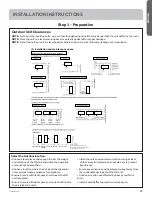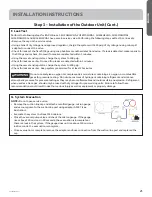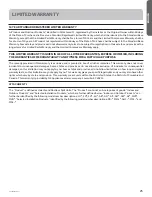
31-5000564 Rev. 1
21
ENGLISH
Step 3 - Installation of the Outdoor Unit (Cont.)
F. Leak Test
Perform the following steps for EACH line set. 2U20EH2VHA, 2U18MS2HDA1, 3U24EH2VHA, 3U24MS2HDA1,
4U36MS2HDA1 and 4U36EH2VHA1 have a main service valve. Performing the following steps will test ALL line sets.
• Remove the cap on the service valve.
• Using a tank of dry nitrogen and approved regulator, charge the system with 150 psig of dry nitrogen using mini-split
adapter to connect the valve.
• Check for leaks at the flare fittings using soap bubbles or another detection device. If a leak is detected, make repairs to
the fittings and recheck. Proceed if no leaks are detected within 3 minutes.
• Using the same tank/regulator, charge the system to 300 psig.
• Check for leaks as earlier. Proceed if no leaks are detected within 3 minutes.
• Using the same tank/regulator, charge the system to 500 psig.
• Check for leaks as earlier. Keep system pressurized for at least 20 minutes.
WARNING
Do not use acetylene, oxygen or compressed air or mixtures containing air, oxygen, or combustible
gases for pressure testing. Do not use mixtures of hydrogen containing refrigerant and air above
atmospheric pressure for pressure testing as they may become flammable and could result in an explosion. Refrigerant,
when used as a trace gas, should only be mixed with dry nitrogen for pressurizing units. Failure to follow these
recommendations could result in death or serious injury as well as equipment or property damage.
INSTALLATION INSTRUCTIONS
G. System Evacuation
NOTE–
Do not open service valve.
• Remove the suction line cap and attach a manifold gauge, micron gauge,
and vacuum pump to the suction line port using adapter AD-87 (see
illustration).
• Evacuate the system to at least 350 microns.
• Close the vacuum pump valve and check the micron gauge. If the gauge
rises above 150 microns in 60 seconds, the evacuation is incomplete or
there is a leak in the system. If the gauge does not rise above 150 microns
in 60 seconds, the evacuation is complete.
• Once evacuation is complete, remove the adapter and hose connection from the suction line port and replaced the
cap.
















































